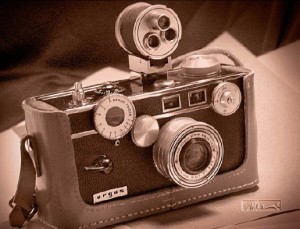An American Original
There was a time when cameras where made out of heavy metal and glass with cases made from real leather. Many were made with a pre-plastic material called Bakelite. Cameras had dials and levers and windows and knobs. They were optical and mechanical wonders. They were beautiful pieces of photo technology. They also had character.
The former International Radio Corporation of Ann Arbor, Michigan, produced a line of American made 35mm rangefinder cameras called the C series. Out of the series, the most popular models were the Model C, C2 and the C3. Barely unchanged since the first version produced in 1938, these C’s ran a long production until 1966. Better known as “The Brick” because of their resemblance in shape, size, and weight, they were one of the bestselling cameras ever produced and sold in the United States.
Argus cameras played a huge role in popularizing the 35mm cassette.
These cameras had interchangeable lenses, a leaf shutter, as well as a coupled rangefinder system. Minor changes and improvements were added throughout the 27year production.
The standard 50mm Cintar lens produces surprisingly sharp and contrasty images. Other interchangeable lenses of the two most popular focal lengths, the Sandmar 35mm f/4,5 and the Sandmar 100mm f/4.5, were produced for Argus by Enna Werk, Munich, Germany. Separate viewfinders were produced for these lenses to allow the photographer to compose images when they were in place. The camera shown above has a special turret viewfinder that can be set for these focal lengths as well as the 50mm. Many third-party companies produced optional accessories for the C’s.
The camera had a shooting sequence where the shutter speed had to be set using the dial at the front left side of the camera. The lens aperture needed to be set on the front of the lens by turning a ring. The shutter had to be cocked using the lever arm on the front right side of the camera. The focus had to be set using the large dial of the coupled rangefinder while viewing the split image in the rangefinder window. The image was then composed through the separate viewfinder. The shutter button was pressed to take the picture. A separate switch was pressed to allow the film to be advanced with the advance knob to set the camera up for the next shot. All of these things were required in order to take a single shot. To take another shot, simply start back at the beginning of the sequence. Whew!
While all that sounds daunting, it is in practice very simple to perform and makes this a very unique and fun camera to use. In fact, the dials and knobs made the camera more appealing from a design point of view, making the camera seem more sophisticated to the buyer of the time.
Many of these cameras are still in service today by people interested in collecting and shooting vintage film cameras. Used C3 cameras are easily available on eBay and can be found at garage sales and thrift stores.
Once you get the bug to collect, it can be difficult to stop buying these whimsical, marvelous and loveable cameras.
You can read about my book “Rethinking Digital Photography” here.
Please have a look at some of my other posts here.
NOTICE of Copyright: THIS POSTING AS WELL AS ALL PHOTOGRAPHS, GALLERY IMAGES, AND ILLUSTRATIONS ARE COPYRIGHT © JOHN NEEL AND ARE NOT TO BE USED FOR ANY PURPOSE WITHOUT WRITTEN CONSENT FROM THE WRITER, THE PHOTOGRAPHER AND/OR lensgarden.com. THE IDEAS EXPRESSED ARE THE PROPERTY OF THE PHOTOGRAPHER AND THE AUTHOR.


